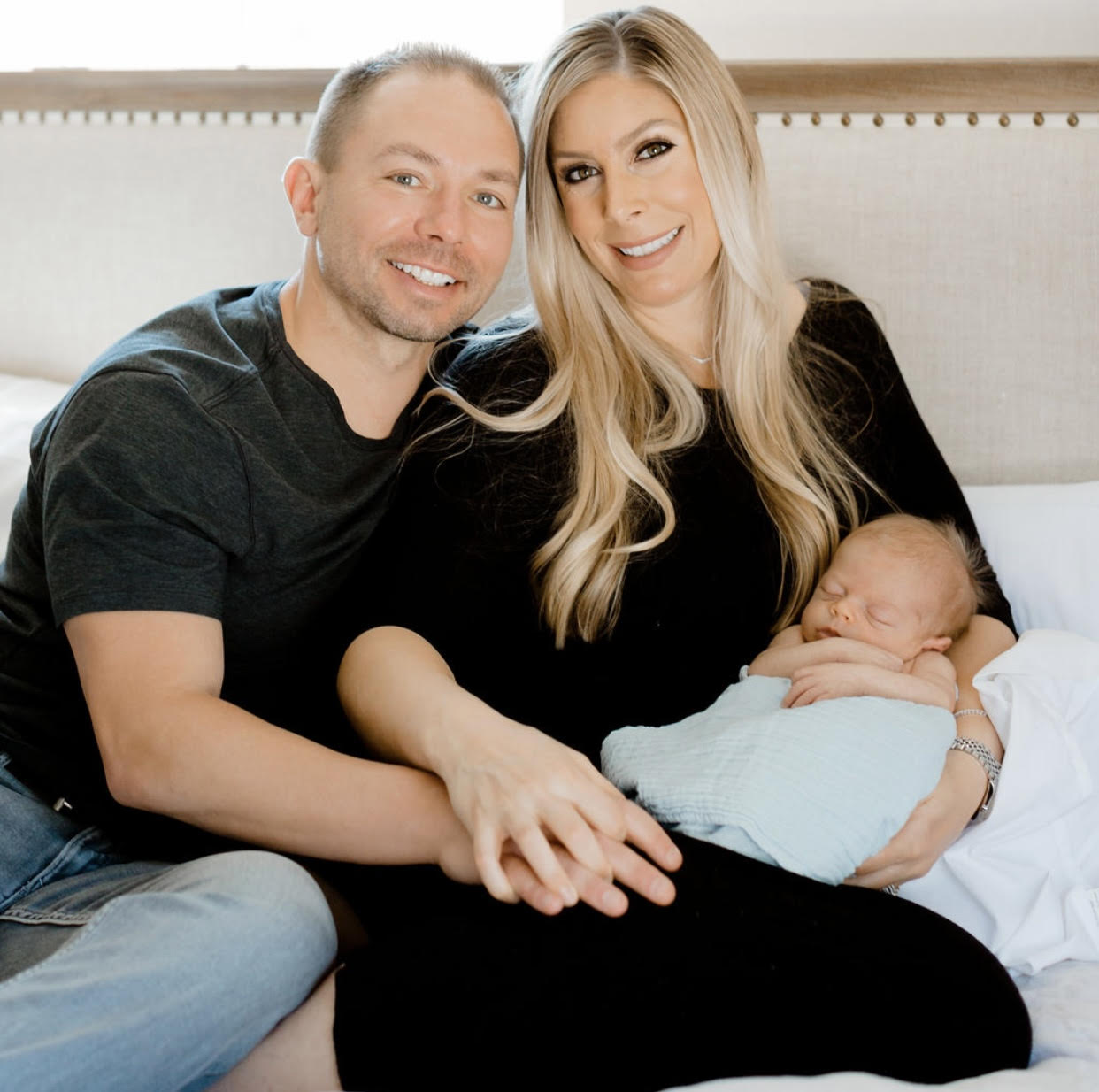Uterine fibroids
Uterine fibroids, also known as leiomyomas, are noncancerous growths that develop in or on the uterus. They can interfere with pregnancy in many ways.
Schedule an AppointmentWhat are fibroids?
Uterine fibroids are firm, noncancerous growths that can develop on the inner or outer wall of a woman’s uterus. Also known as leiomyomas or myomas, uterine fibroids are not associated with an increased risk of gynecologic cancer.
Fibroid growth, quantity and size vary greatly. Some tumors may be too small for the human eye to see, others may be large enough to expand and distort the uterus. While uterine fibroids are typically not found outside of the pelvic cavity area, they can appear on a woman’s cervix or attached to organs near the uterus, such as the bowel or bladder. Types of uterine fibroids include:
- Subserosal fibroids are attached to the outside of the uterine wall and make up about 55 percent of fibroid cases.
- Intramural fibroids grow within the muscle layer of the uterine wall and are responsible for about 44 percent of fibroid cases.
- Submucosal fibroids are found in the uterine cavity and cause about 5 percent of fibroid cases.
Uterine fibroids are common in women of reproductive age. As many as 3 in 4 women will develop uterine fibroids by the time they are 50 years old. However, not all women will experience symptoms and many will be unaware that they have fibroids unless a doctor discovers them during a pelvic exam or ultrasound.
What causes fibroids?
The exact cause of uterine fibroids is unknown. Hormonal factors can play a role in the development of the tumors. Anti-hormone medications, such as leuprolide, that suppress a woman’s estrogen levels temporarily cause the fibroids to shrink. Additionally, fibroids will often grow rapidly during pregnancy but will stop developing when a woman reaches menopause, indicating a link to hormones.
Risk factors for developing fibroids include:
- Family history: According to the Office on Women’s Health, a woman is 3 times more likely to develop fibroids if her mother or another family member has had them.
- Age: Fibroids are most common in women who are 30 to 50 years old. Women nearing menopause often have the highest risk for developing fibroids because of their lengthy estrogen exposure, but the tumors often shrink after menopause.
- Obesity: Women who are obese are 2 to 3 times more likely to develop uterine fibroids.
- Eating habits: Consuming large amounts of red meat and ham in particular are also linked to fibroid growth.
- Early menstruation: If a woman experienced her first menstrual cycle before age 10, she is at higher risk.
- Ethnicity: Certain ethnicities are more likely to develop fibroids, although the exact genetic link is unknown.
Symptoms of fibroids
Many women do not experience symptoms from uterine fibroids. However, some cases are very painful. Uterine fibroids may be present if a woman has any of the following symptoms:
- Heavy menstrual bleeding, bleeding between periods and/or prolonged periods (seven days or more).
- Pressure or pain in the pelvis.
- Enlargement of and pressure in the lower abdomen.
- Constipation.
- Painful sexual intercourse.
- Frequent urination from fibroid pressure on the bladder.
- Lower back pain.
If you experience these symptoms, consulting a fertility specialist can provide clarity and guidance.
How fibroids affect fertility
Not every woman with fibroids will experience infertility. When fibroids do result in infertility, they generally cause the following conditions:
- Changes in the size of the uterine cavity lining, affecting movement of sperm or making it difficult for the embryo to implant.
- Changes in the shape of the cervix or uterus, also disturbing sperm or embryo movement.
- Blocked fallopian tubes inhibiting sperm from reaching the eggs and an embryo from passing into the uterus.
- Impaired blood flow to the uterine cavity, impeding an embryo’s implantation in the uterine lining for pregnancy.
Consulting a fertility specialist early is essential to managing the condition and optimizing your fertility outcomes.
Diagnosing fibroids
Your medical history and a pelvic exam are necessary for diagnosing fibroids. Listed below are tests that your physician may also use to confirm the diagnosis:
- Ultrasound: A scan that uses high-frequency sound waves to detect fibroids in and around the uterus and cervix.
- Hysterosalpingogram (HSG): A procedure that uses x-rays and a special dye to detect fibroids on the inside of your uterus and to see if your Fallopian tubes are open.
- Hysteroscopy: A procedure in which your doctor uses a narrow fiber-optic telescope inserted into the uterine cavity to look for and sometimes remove fibroids.
- Laparoscopy: A procedure in which your doctor uses a narrow fiber-optic telescope inserted through an incision near your navel to look for and sometimes remove fibroids.
Fertility treatment options for fibroids
It’s important to know that treatments do not cure fibroids, rather they manage them — new fibroids can regrow after treatment. To treat fibroids, your doctor may want to take care of them surgically, with medications, or with a combination of both. There are several surgical options to remove fibroids:
- Myolysis uses electric currents or freezing to destroy fibroids by inserting a needle, directed by a laparoscope, into the tumor.
- Hysterectomy removes the uterus and is the only way to cure uterine fibroids unconditionally. A physician may recommend hysterectomy if the woman is nearing or past menopause, has large fibroids, experiences unusually heavy menstrual bleeding or does not want children.
- Myomectomy removes fibroids without disrupting the healthy uterine tissue and is suggested for women who want children in the future. Myomectomy can be performed through an incision in the abdomen. Depending on the size of the fibroids, it may also be performed as a minimally invasive surgery with laparoscopy. This utilizes special instruments and a thin, lighted tube with camera inserted through a small incision that provides a view of the uterus.
- Endometrial ablation destroys the lining of the uterus using wire, boiling water, electric current, laser or freezing. Approximately half of the women who undergo endometrial ablation no longer have menstrual bleeding. This is typically an outpatient procedure with few risks. However, a woman will no longer be able to bear children.
- Uterine fibroid embolization (UFE) inserts a thin tube into the blood vessels that supply blood to a fibroid. Tiny plastic or gel particles are injected into the blood vessel to block the supply to the fibroid, causing it to shrink. While not all fibroids can be treated with UFE, doctors typically recommend the procedure for women who do not want a hysterectomy or who have fibroids that are causing heavy bleeding, pain and pressure. UFE may make it impossible for a woman to have children.
Our specialists will work closely with you to determine the best approach, combining medical expertise with compassionate care.
Take control of your fertility journey
Uterine fibroids don’t have to stand in the way of your dreams of parenthood. At RSC, we’re committed to helping you understand your condition, explore your options, and take confident steps forward.
More about fibroids
Patient Story
Michelle
Patient Story



